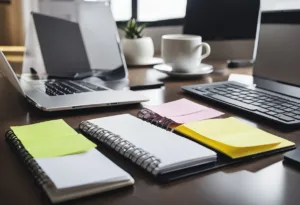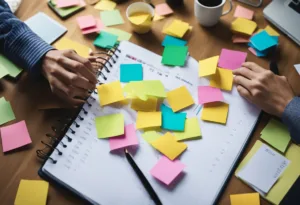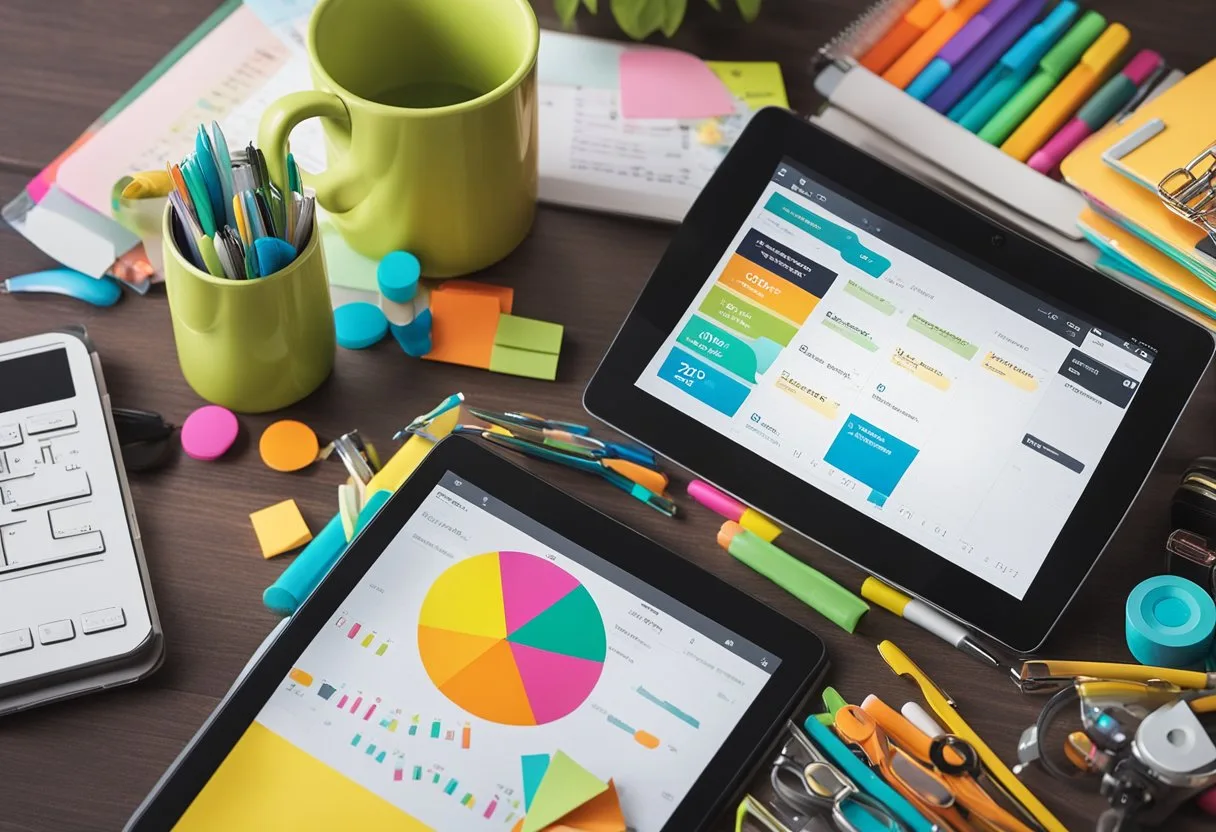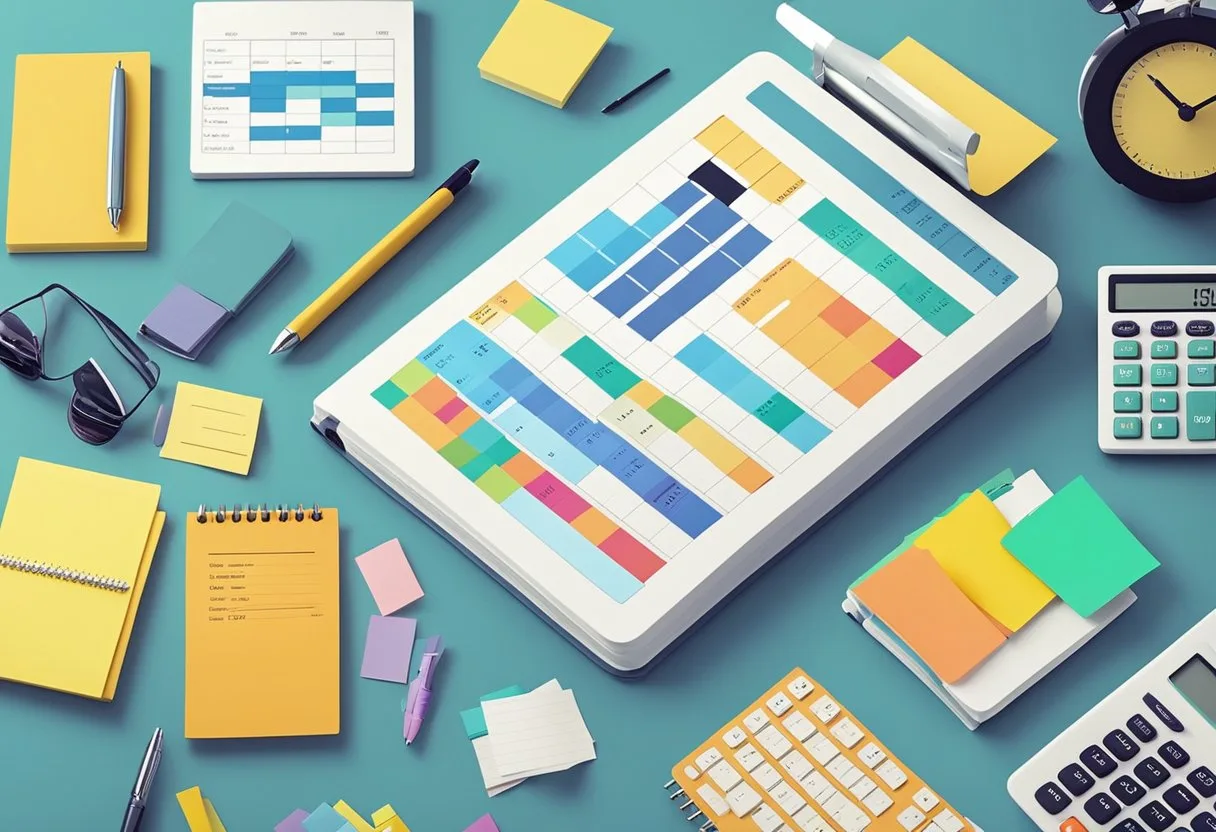Planners can be an essential tool for organizing and prioritizing tasks, appointments, and deadlines. However, not everyone knows how to make the most of their planner. Whether you’re a beginner or an experienced planner user, there are always ways to improve your planning skills and increase your productivity. In this blog post, I will share with you 15 planner tips to help you stay organized and productive in your daily life.
One tip for effective planning is to set realistic goals and prioritize tasks accordingly. By breaking down larger tasks into smaller, more manageable steps, you can avoid feeling overwhelmed and stay on track. Another important aspect of planning is to regularly review and update your planner, so you can adjust your schedule as needed and ensure that you’re making progress towards your goals.
Choosing the Right Planner
Choosing the right planner is an important step towards achieving your goals and staying organized. There are several factors to consider when selecting a planner, including the type of planner, layout and design, and accessories and supplies.
Type of Planner
The first step in choosing a planner is deciding on the type of planner that best fits your needs. There are two main types of planners: digital and paper. Digital planners are becoming increasingly popular due to their convenience and accessibility.
They can be accessed from multiple devices and offer features such as reminders and syncing with other apps. However, some people prefer the tactile experience of a paper planner, and find that writing things down helps them remember better.
Layout and Design
Once you have decided on the type of planner, the next step is to consider the layout and design. Planners come in a variety of layouts, including daily, weekly, and monthly formats. It is important to choose a layout that works best for your needs and goals.
For example, if you have a lot of appointments and tasks to keep track of, a daily planner may be the best option. On the other hand, if you want to see your schedule at a glance, a monthly planner may be more suitable.
In addition to the layout, the design of the planner is also important. Some people prefer a minimalist design, while others like to use stickers, color coding, and tabs to make their planner more visually appealing. It is important to choose a design that motivates and inspires you to use your planner consistently.
Accessories and Supplies
Finally, when choosing a planner, it is important to consider the accessories and supplies that you will need. Some popular planner supplies include erasable pens, markers, and washi tape. These supplies can be used to decorate your planner and make it more functional. However, it is important to not go overboard with accessories, as this can make your planner cluttered and difficult to use.
Choosing the right planner is an important step towards achieving your goals and staying organized. When selecting a planner, consider the type of planner, layout and design, and accessories and supplies that best fit your needs and goals. By choosing a planner that works for you, you can increase your productivity and achieve your goals with ease.
15 Planner Tips To Stay Organized

Set Clear Goals
One of the most valuable planner tips is to set clear and achievable goals. When you articulate what you want to accomplish, your planner becomes a roadmap to success. Use your planner to break down each goal into smaller, manageable tasks, and set deadlines for each milestone.
This approach keeps you focused and motivated, providing a visual representation of your progress. By regularly reviewing and updating your goals, you ensure that your planner adapts to your evolving priorities, making it an indispensable tool for personal and professional growth.
Prioritize Your Tasks
Effective prioritization is a cornerstone among planner tips. Not all tasks are created equal, and your planner should reflect that. Begin by identifying the most critical tasks that require immediate attention and mark them as high-priority.
This allows you to allocate your time and energy where it’s needed most. Use color-coding, symbols, or sections within your planner to visually separate these tasks from less urgent ones. By focusing on priority tasks, you minimize the risk of becoming overwhelmed and ensure that you’re making the best use of your time.
Be Consistent
Consistency is key when it comes to planner tips. To reap the full benefits of using a planner, make it a daily habit. Dedicate a few minutes each morning or evening to review and update your planner. This routine ensures that your planner is always current and that you’re mentally prepared for the day ahead.
Consistency also helps to solidify the habit of using your planner, making it second nature to record and check tasks, appointments, and notes. Over time, this consistency will lead to improved organization and productivity.
Planner Tips: Keep It Accessible
Another crucial planner tip is to keep your planner accessible at all times. Whether it’s a physical planner that you carry with you or a digital planner on your mobile device, accessibility ensures that you can always add new tasks, appointments, or notes as they arise.
This immediate recording of information prevents important details from slipping through the cracks. Having your planner at arm’s reach also allows for quick reference, keeping you on track throughout your day.
Review Regularly
Regular reviews are an essential planner tip to stay on top of your commitments and progress. Set aside time each week to go through your planner in detail. This review session is the perfect opportunity to check off completed tasks, assess what needs to be carried over to the next week, and adjust plans as necessary.
A weekly review helps you to stay aligned with your goals and ensures that nothing important is overlooked. It’s also a moment to reflect on your achievements, which can be a great motivational boost.
Use Time Blocking
Time blocking is a strategic planner tip that involves allocating specific blocks of time to different tasks or activities. By scheduling when you’ll focus on a particular task, you minimize distractions and increase productivity. Time blocking can be especially effective for larger projects that require deep focus. Use your planner to visually block out time on your calendar, and treat these blocks as you would any other important appointment.
Be Flexible
Flexibility is an often-overlooked planner tip. While it’s important to have a plan, it’s equally important to adapt when unexpected events occur. Use your planner as a flexible tool that can accommodate changes.
Instead of packing your schedule with back-to-back tasks, leave some buffer time for adjustments. When you allow for flexibility, you reduce stress and can more easily shift priorities as needed without disrupting your entire plan.
Color Code for Clarity
Color coding is a visually engaging planner tip that can bring clarity and organization to your schedule. Assign different colors to various types of tasks, such as work, personal, health, and social activities. This method makes it easy to see at a glance what types of commitments you have on any given day. Color coding also adds a fun and personalized touch to your planner, making the planning process more enjoyable.
Keep It Simple
Simplicity is one of the most effective planner tips. A cluttered planner can be overwhelming and counterproductive. Keep your planner simple by only including what’s necessary. Avoid overcomplicating your system with too many codes, symbols, or sections. A simple, streamlined approach ensures that your planner remains a practical tool that enhances your productivity, rather than becoming a source of stress.
Incorporate Self-Care
Incorporating self-care into your planner is a vital tip for maintaining balance. Use your planner to schedule regular self-care activities, such as exercise, hobbies, or relaxation time. By treating these activities with the same importance as other appointments, you ensure that they’re not overlooked. Self-care is crucial for your overall well-being and can significantly impact your ability to stay productive and focused.
Use Stickers and Symbols
Utilizing stickers and symbols is a creative planner tip that can make the process more engaging and efficient. Stickers can highlight important dates or tasks, and symbols can quickly convey the status of a task (e.g., an asterisk for priority or a checkmark for completion). These visual aids not only make your planner more aesthetically pleasing but also help you to process information quickly.
Track Your Progress
Tracking progress is an encouraging planner tip that can boost your motivation. Use your planner to note milestones and progress toward your goals. Seeing how far you’ve come can provide a sense of accomplishment and drive you to continue moving forward. Regularly tracking progress also helps you to identify any areas where you might be falling behind, allowing you to adjust your plans accordingly.
Declutter Regularly
Decluttering your planner is a practical tip to maintain its usefulness. Periodically go through your planner and remove outdated tasks, irrelevant notes, or completed projects. This decluttering process keeps your planner focused on current and upcoming items, reducing distractions and helping you to concentrate on what’s important. A clean and organized planner is more inviting and easier to use.
Personalize Your System
Personalizing your planner system is a crucial tip for making it work for you. Tailor your planner to fit your lifestyle, preferences, and the way your mind works. Whether you prefer daily, weekly, or monthly spreads, choose a layout that complements your planning style. The more your planner reflects your personal needs, the more likely you are to use it consistently.
Reflect and Adjust
A final planner tip is to regularly reflect on your planning system and make adjustments as needed. What works for you now may not work in a few months. Take time to consider what aspects of your planner are helping you stay organized and which parts could be improved. Continuous reflection and adjustment ensure that your planner remains an effective tool for managing your life.
Setting Up Your Planner

Setting up a planner can be a daunting task, but with a little organization and planning, it can be a breeze. Here are some tips to help you set up your planner and make it work for you.
Important Dates and Deadlines
The first step in setting up your planner is to add all important dates and deadlines. This includes birthdays, anniversaries, and any other important events. It is important to make sure that all of these dates are entered into your planner so that you do not forget them.
To make it easier to see these dates at a glance, you can use color-coding or labels. For example, you can use a different color for birthdays or anniversaries, or you can add a label to important events. This will make it easier to quickly identify important dates.
Organizational Structure
Once you have added all important dates and deadlines, it is time to set up your planner’s organizational structure. This includes deciding on a schedule that works for you, choosing a calendar view, and deciding on a monthly and weekly review process.
When choosing a schedule, it is important to consider your work and personal life. You should choose a schedule that allows you to balance both and that works for you.
When choosing a calendar view, you should consider how much detail you want to see. For example, if you prefer to see a lot of detail, you may want to choose a daily view. If you prefer to see a broader overview, you may want to choose a monthly view.
Finally, it is important to set up a monthly and weekly review process. This will help you stay on track and make sure that you are meeting your goals. During your monthly review, you should review your progress and make any necessary adjustments. During your weekly review, you should review your upcoming tasks and deadlines and make sure that you are prepared for the week ahead.
Daily and Weekly Planning Strategies

When it comes to planning, it’s essential to have a system that works for you. Daily and weekly planning strategies are two popular methods that can help you stay organized, focused, and productive.
Time Management Techniques
Time management is a crucial aspect of daily and weekly planning. It’s essential to have a clear understanding of how much time you have available and how to use it effectively. One time management technique that can help is time blocking. Time blocking involves scheduling specific blocks of time for specific tasks or activities. It ensures that you’re making the most of your time and staying on track.
Another time management technique is to use checklists. Checklists can help you stay organized and focused on your tasks. They can also be a great way to track your progress and ensure that you’re making the most of your time.
Prioritizing Tasks
Prioritizing tasks is another critical aspect of daily and weekly planning. It’s essential to focus on the most important tasks first and work your way down the list. One effective way to prioritize tasks is to use the “top three” method. This involves identifying the top three most important tasks for the day or week and focusing on those first. Once you’ve completed those tasks, you can move on to the rest of your to-do list.
Another way to prioritize tasks is to focus on unfinished tasks from the previous day or week. By tackling these tasks first, you can ensure that you’re making progress and not falling behind.
Daily and weekly planning strategies can be incredibly effective in helping you stay organized, focused, and productive. By using time management techniques and prioritizing tasks, you can make the most of your time and achieve your goals.
Maintaining and Updating Your Planner

To make the most of your planner, it is important to keep it up to date and use it regularly. This section will cover two important aspects of maintaining and updating your planner: tracking progress and adjustments, and regular reviews and brain dumps.
Tracking Progress and Adjustments
One of the most important things to keep in mind when using a planner is that it should be flexible. This means that you should be willing to make adjustments as needed to keep up with changes in your schedule or priorities. It is also important to track your progress towards your goals and adjust your plans accordingly.
To track your progress, you can use a variety of methods such as checklists, notes, or progress bars. These tools can help you stay focused and motivated as you work towards your goals. It is important to be mindful of actionable items and to-dos that need to be completed in order to make progress towards your goals.
Regular Reviews and Brain Dumps
In addition to tracking progress and making adjustments, it is also important to regularly review your planner and brain dump any new ideas or tasks that come to mind. This can help you stay organized and ensure that you don’t forget anything important.
One way to do this is to schedule regular reviews of your planner. This could be a weekly or monthly review where you take the time to go through your planner and make any necessary adjustments. During these reviews, it can be helpful to use a pre-planning checklist to ensure that you are prepared for the week or month ahead.
Another important aspect of maintaining your planner is to regularly brain dump any new ideas or tasks that come to mind. This can help you stay focused and ensure that you don’t forget anything important. To do this, you can use a variety of methods such as a dedicated brain dump page in your planner or a separate notebook.
Maintaining and updating your planner is an important part of staying organized and productive. By tracking progress and adjustments, and regularly reviewing and brain dumping, you can ensure that you are making the most of your planner and staying on top of your goals and priorities.
Advanced Planner Tips and Tricks
Creative Enhancements
To make planning more enjoyable and creative, one can use colored pens and functional stickers to highlight important tasks or events. This can help in improving motivation and habit formation. By making the planner visually appealing, one can be more likely to stick to their goals and use the planner more consistently.
One can use creativity to make grocery lists and budget planning more fun and engaging. For example, using different colors for different categories of items or expenses can make it easier to read and organize the list. This can also help in setting and achieving financial goals.
Integrating Digital Tools
For those who prefer digital planners, Microsoft Planner can be a great tool for task management and scheduling. One can use the emoji picker to add emojis to tasks, which can make it easier to visually identify different types of tasks or recurring tasks.
Moreover, integrating digital tools like Google Calendar or Trello with the planner can help in creating a more comprehensive and organized scheduling system. This can help in improving productivity and achieving goals.
Frequently Asked Questions

What are the best strategies for organizing a yearly planner to maximize productivity?
To maximize productivity, it’s important to have a clear understanding of your goals and priorities. Start by breaking down your long-term goals into smaller, actionable steps that can be accomplished on a daily or weekly basis. Use your planner to schedule these steps and track your progress. Color-coding different types of tasks can also help you stay organized and focused.
How can beginners effectively incorporate daily planning into their routine?
Beginners can start by setting aside a few minutes each day to plan out their tasks and appointments. Use your planner to create a to-do list and prioritize your tasks. It’s important to be realistic about what you can accomplish in a day and to leave some buffer time for unexpected tasks or interruptions. Consistency is key, so try to make daily planning a habit.
What are some creative planner ideas for students to enhance their academic planning?
Students can use their planner to keep track of assignments, deadlines, and exam dates. Color-coding different classes or subjects can help keep things organized. Consider using stickers, washi tape, or other decorative elements to make your planner more fun and engaging. You can also use your planner to set academic goals and track your progress.
What are the key features to look for when choosing the best planner for beginners?
When choosing a planner, beginners should look for a layout that is easy to use and understand. A weekly or daily format with space for notes and to-do lists is a good place to start. Consider the size and portability of the planner, as well as any additional features such as goal-setting pages or habit trackers.
How can I use a weekly planner to efficiently organize my tasks and appointments?
A weekly planner can be a great tool for organizing your tasks and appointments. Start by reviewing your schedule for the week and blocking out time for important tasks or appointments. Use your planner to create a to-do list for each day, and prioritize your tasks based on their importance and urgency. Consider color-coding different types of tasks to help you stay organized.
What are the top Microsoft Planner tips to improve project management and team collaboration?
Microsoft Planner is a powerful tool for project management and team collaboration. Some top tips include creating clear and specific tasks, assigning tasks to team members, setting due dates and reminders, and using the comments section to communicate and collaborate with team members. Consider using labels or categories to group related tasks, and use the progress tracker to monitor your team’s progress towards your goals.




